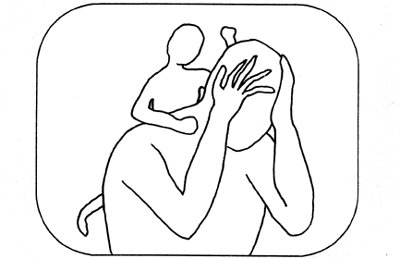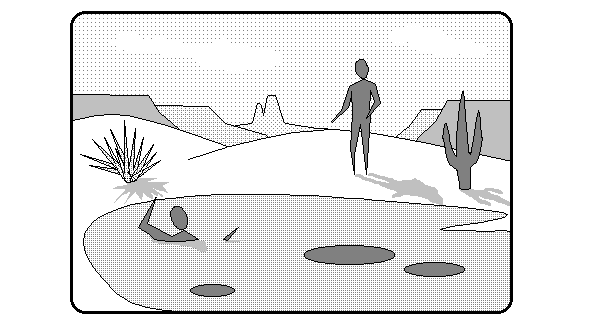by Bob Daniel, Ph.D.
There once was a man with a monkey on his back – well, not a real monkey, but he thought it was real – at least, I think he thought it was real. (But I’m getting ahead of myself now.) Anyway, he came to me to help him get rid of his monkey. It wasn’t just his having this monkey on his back that was the problem – he could probably handle that. Rather, it was how his monkey treated him – that is, if you believe his story. He complained about how his monkey kept a running commentary on his life, and it was all negative. For anything that he would do, say, or even think, his monkey always found something bad to say about it: he was always too stupid, clumsy, too lazy, too weak, too immature, too crazy, or whatnot. Everything he did, he messed up in one fashion or other, and he always felt the harsh scrutiny of his companion. Finally, he reached a level of desperation he could no longer tolerate.
It was at this point that he found his way to me in his quest to rid himself of his monkey. Now I did as I usually do when seeing a new patient – I took his social history. When I got around to asking him about how long his monkey had been with him, he told me that he couldn’t remember ever being without him. He then recalled how he had told his classmates about the monkey. Nothing he would say could convince them of the reality of his monkey. And the way they ridiculed and teased him when he mentioned it rivaled even the monkey’s worst criticism. So he learned the hard way not to complain about his monkey. It wasn’t long before he stopped trying – he even scoffed when someone brought it up. “Monkey?” he’d ask, “What monkey? There ain’t no monkey. You got to be crazy!” After enough denial, he himself even questioned whether this monkey actually existed. So he bore the judgment and ridicule in silence, until he could stand it no more.
At this point, though, he had no doubt about the reality of his monkey. While he trusted me with his secret, he staunchly maintained this conviction. As we psychologists often do in such circumstances, I challenged the reality of his irrational beliefs. First, I asked whether others saw his monkey, to raise doubt in his mind. He paused, before replying, “No, I can’t recall that anyone else ever has.” When I asked what this suggests to him, he responded, “I don’t know, Doc, but you’ve got to get rid of him for me.” Then, I got much the same response when I asked whether anyone else ever heard his monkey. All he wanted to know was if I’d rid him of his monkey.
At this point, I decided to play my trump card, “You say your monkey criticizes you for what you do or say or even think? Now, how does your monkey know what you’re thinking? He can’t read minds, now, can he?”
He paused for quite a while, then spoke, “I don’t know how it works, Doc. It’s just like the monkey says – that I’m too stupid to figure it out. All I know, is that you’ve just got to get rid of him for me.” Well, so much for my “gotcha” question.
Having been unsuccessful at probing and challenging his reality, I felt stuck as to what else to do next. So I did what most self-respecting psychologists do in such situations – I referred him to a psychiatrist, who could prescribe medication to rid him of his hallucinations. He was excited about this prospect and readily agreed to the appointment. So he showed up for his appointment as scheduled, and I saw him about a week later. When I asked him how the medication worked, he replied, “Nah, it didn’t do any good at all.” When I asked him how long he had been taking it, he appeared perplexed, “What do you mean, Doc? I thought the pills were for the monkey. And I couldn’t get him to take them.” When I explained that he was to take the medication himself, he appeared startled. He was quite mistrustful about being drugged, and he simply could not understand how taking the medication himself would make the monkey go away.
He repeated his request that I rid him of his monkey, and then he asked me to perform an exorcism. I attempted to refer him to a priest for such matters, with no success. He explained that he had already tried that route, to no avail: the priests limit these rituals to casting out devils, and his monkey posed a more secular dilemma. Having no other options in mind, I returned to my drawing board. Eventually, I cooked up a half-baked plan to perform a ritual. In part, I drew upon my knowledge of hypnotic techniques for this procedure. During my graduate class in hypnosis, I had succeeded in inducing a negative hallucination (i.e., an inability to see an object which is actually there), so this background offered some plausibility for success. Maybe I could induce an inability to see an object which is not there! I studied up on esoteric rites, and agreed to perform an exorcism, even though I knew very little about such procedures and I doubted my own ability to pull it off. I figured that the ceremony might do him some good, and probably would do no harm. After all, it was hard to imagine him being any worse off than he already was. And if it somehow worked at ridding him of his phantom, the procedure might provide some relief, even if he still believed in his monkey.
The exorcism worked beyond my wildest expectations. The next week he reported that his monkey had totally vanished, and that he experienced freedom as never before. There was no one to put him down or tell him how he messed up. While he was ecstatic, I was more cautious, asking him to return the following week. Then, he still appeared content, though not quite so excited. The next week he appeared rather bland, and then downright miserable the following week. Eventually he seemed about as depressed as before, and I had much less access to his problem than before. After all, at least as long as he experienced the monkey with him, I could question that. But how can you effectively challenge a belief in a monkey that had disappeared? Still, I had to probe, so I asked him what was the matter. He confessed that he was lonely and aimless, and that he missed the monkey, his closest companion. Even with all the abuse, the monkey had stayed with him and had given him a sense of direction, even if he could never seem to follow it. Without his monkey, he was utterly lost. At this point, I encouraged him to stay with his grief and assured him that he would eventually feel better after mourning his loss.
Well, the following week the man returned in better spirits. Naively, I assumed he had somehow turned the corner and I confidently asked him what had happened. He sheepishly looked away and sighed, “He’s back – the monkey.” With his head lowered, he finally admitted, “I invited him back.” I was torn with doubt – perhaps my excursion into magical ritual had been foolhardy, and I should have stuck with my traditional therapeutic tools. On the other hand, I could once again challenge his delusional belief in the reality of his monkey. Still, I realized that I would have to wait until he again felt sufficient distress to want to rid himself of his monkey, whether real or not. I didn’t have long to wait, for in a couple of weeks he was just as despondent as before. Again, I applied all of my challenges involving empirical tests, consensual validation and logic. I remained hopeful that such reality testing would dispel him of his delusional notions. Alas, it was all futile, just as before. He again asked me to rid him of his monkey. Having again made no headway with my usual methods, I figured that I might have greater leverage in granting his second request. I again agreed to perform the exorcism, but only under the condition that he agree not to invite the monkey back. I explained that he would have to mourn the loss of his fiendish friend before he could eventually settle into his more solitary existence. He agreed, and I again performed the exorcism, still unsure of the outcome.
To my surprise the procedure worked a second time: the man was again happy, though not as euphoric as before. And in the succeeding weeks the happiness gradually faded into despair, as before. But this time he persisted, though not without complaint. He pleaded with me to tell him what he should do, and he was obviously frustrated when I refused to answer or simply suggested that he should just wait it out. Sensing his pain and desperation, I finally relented and offered what I considered to be a few helpful suggestions for stress management and emotional regulation, but they only backfired. When he found that he couldn’t follow them successfully, he felt terribly inadequate. He was sure that I was despising him for his shortcomings, even speculating that I had gotten somehow in cahoots with his monkey. I had almost gotten stuck in the web of paranoia that I had implicitly condoned with the exorcism experiment. Still, I managed to extricate myself by observing that he was treating himself just as badly as his monkey ever did and that he was assuming that I would do the same. This reassured and comforted him, and he again promised to try my suggestions.
The following week he returned, glaring and fuming, reporting that he had tried my techniques and that they were utterly useless. He accused me of gross incompetence and quackery. With the failure of my unorthodox measures, I was now doubting myself. Then it occurred to me that this must be how he continuously felt with his monkey on his back. I must have muttered this under my breathe, for he remarked, “You get it, Doc.” A burden was now lifted from both of us, and he again vowed to persist in his struggle to endure without his monkey.
After a few more weeks his mood improved, and he appeared relaxed and free. I was again pleased with the results, though more cautious about my assumptions. So I asked him what happened. And again he gave me that sheepish look and lowered his eyes. He must have read the dismay on my face, for he reassured me, “No, not the monkey.” After a pause, he beamed, “It’s my fairy godmother.” I was crestfallen, for I felt I had only entrenched him further into his psychotic world. It was little comfort to me that his phantom friend was now a more benign creature, for she would be even more difficult to dislodge.
The man saw my shock and dismay, despite my efforts to hide my reactions. He tried to reassure me, “Doc, thank you for your tremendous help. Whereas I had the burden of an abusive monkey as my constant companion, now I have a helpful, supportive fairy godmother. Sure, she doesn’t tell me exactly what I should do, but she does give me confidence for making my own decisions. Even when I make a mistake, she is supportive. She even asks me what I might learn from it. Sure, it’s difficult not having the sense of direction implied by my monkey’s criticism, but I’m learning to accept that. I’m even enjoying a sense of adventure in not knowing the right way, and surprise with not knowing what to expect. Yes, it was even more difficult to deal with the loneliness after the monkey left and before she came. The silence, day after day, was unnerving. I longed for some voice, any voice, for company, if not for direction. If it weren’t for you, Doc, I would have gone back to that monkey. But you encouraged me to persist, until I found my fairy godmother. I’ll be eternally grateful to you, and I want to let everyone know what you’ve done for me.”
While I was pleased with his apparent improvement, it also raised my apprehension. I imagined his unsolicited testimony reaching my colleagues. I then fantasized their amusement over this so-called “success,” which actually involved my patient becoming further entrenched in his now-expanded delusional system. I pictured their ridicule and taunting, and perhaps even their professional censure. How would I justify my unorthodox techniques? Afterall, I know of no studies supporting exorcism as an “evidence-based” psychological intervention. A wave of humiliation swept over me over this scenario, which so far existed only in my overactive imagination.
Gradually, my shame gave way to incredulity. I now suspected that these reported companions were simply figures of speech, rather than true apparitions. I felt compelled to probe: “Do you see your fairy godmother as plainly as you see me?” “What does she look like?” “Do you see her out there, or is she like on a projection screen inside your head?” “Do you hear her voice out there, or is it just inside your head?” “Can you describe what or who she sounds like?” “Do you hear it with your ears, or is it more like a thought?” I tried all angles I could imagine to determine just how real these figures were for him. I rephrased the questions a number of ways, and I again asked similar ones about the monkey. Regardless of my approach, he simply smiled in response. I could not tell whether his smiles expressed mirth or mischief, and he refused to answer me. Finally, in my impatience, I demanded, “Look – bottom-line, are the fairy godmother, and the monkey, for that matter, real for you?”
Finally, He responded. He looked me square in the eye and asked, “Doc, why is that so important to you?” I wish that I could share some clever rejoinder with which to punctuate this story, but I was speechless. And that is where the story stands, even to this day.






